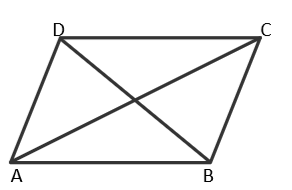
The points (-5,12), (-2,-3),(9,-10),(6,5) taken in order, form
(A). Parallelogram
(B). Rectangle
(C). Rhombus
(D). Square
Answer
593.1k+ views
Hint- In this above question we are provided with some specific points and we can name them ABCD. By using these points we can find out the sides by using the formula $\sqrt {{{({x_1} - {x_2})}^2} + {{({y_1} - {y_2})}^2}} $ . thus we can find the answer.
Given points $ A(−5,12), B(−2,−3), C(9,−10), D(6,5)$
Complete step-by-step solution -
Distance AB=\[\begin{gathered}
\sqrt {{{( - 5 + 2)}^2} + {{(12 + 3)}^2}} \\
\sqrt {234} \\
\end{gathered} \]
Distance BC=$
\sqrt {{{( - 2 - 9)}^2} + {{( - 3 + 10)}^2}} \\
\sqrt {170} \\
$
Distance CD=$
\sqrt {{{(9 - 6)}^2} + {{( - 10 - 5)}^2}} \\
\sqrt {234} \\
$
Distance AD=$
\sqrt {{{( - 5 - 6)}^2} + {{(12 - 5)}^2}} \\
\sqrt {170} \\
$
Distance AC=$
\sqrt {{{( - 5 - 9)}^2} + {{(12 + 10)}^2}} \\
\sqrt {680} \\
$
Distance BD=$
\sqrt {{{( - 2 - 6)}^2} + {{( - 3 - 5)}^2}} \\
\sqrt {128} \\
$
If we See AB=CD and BC=AD
Now we use the Pythagoras theorem to find whether the two adjacent lines make a right angle or not. so, for point A,B,C if ${{(AC)}^2} ={{(AB)}^2+ {(BC)}^2}$ then AB and BC will have the right angle.
${{AB}^2 + {BC}^2}$ = ${\sqrt {234}}^2$ + ${\sqrt {170}}^2$ = 404
$\Rightarrow {(AC)}^2$ = ${\sqrt {680} }^2$ = 680
Here ${{(AC)}^2} \ne {{[(AB)}^2+ {{(BC)}^2}]}$ on solving like this we have ${{(BD)}^2} \ne {{[(AB)}^2 + {{(AD)}^2}]} $.
These opposite pairs of sides are equal and there is no right angle . So these points form a parallelogram. Hence, the correct option would be a. parallelogram.

Note- In this question we should have the basic knowledge of knowing and applying the formulas, as in the question we were stated four different points and we had to find the figure as by using a basic formula to find the sides of the figure we easily found the answer. As the question provides half of the information and formulas helps in finding the missing part.
Given points $ A(−5,12), B(−2,−3), C(9,−10), D(6,5)$
Complete step-by-step solution -
Distance AB=\[\begin{gathered}
\sqrt {{{( - 5 + 2)}^2} + {{(12 + 3)}^2}} \\
\sqrt {234} \\
\end{gathered} \]
Distance BC=$
\sqrt {{{( - 2 - 9)}^2} + {{( - 3 + 10)}^2}} \\
\sqrt {170} \\
$
Distance CD=$
\sqrt {{{(9 - 6)}^2} + {{( - 10 - 5)}^2}} \\
\sqrt {234} \\
$
Distance AD=$
\sqrt {{{( - 5 - 6)}^2} + {{(12 - 5)}^2}} \\
\sqrt {170} \\
$
Distance AC=$
\sqrt {{{( - 5 - 9)}^2} + {{(12 + 10)}^2}} \\
\sqrt {680} \\
$
Distance BD=$
\sqrt {{{( - 2 - 6)}^2} + {{( - 3 - 5)}^2}} \\
\sqrt {128} \\
$
If we See AB=CD and BC=AD
Now we use the Pythagoras theorem to find whether the two adjacent lines make a right angle or not. so, for point A,B,C if ${{(AC)}^2} ={{(AB)}^2+ {(BC)}^2}$ then AB and BC will have the right angle.
${{AB}^2 + {BC}^2}$ = ${\sqrt {234}}^2$ + ${\sqrt {170}}^2$ = 404
$\Rightarrow {(AC)}^2$ = ${\sqrt {680} }^2$ = 680
Here ${{(AC)}^2} \ne {{[(AB)}^2+ {{(BC)}^2}]}$ on solving like this we have ${{(BD)}^2} \ne {{[(AB)}^2 + {{(AD)}^2}]} $.
These opposite pairs of sides are equal and there is no right angle . So these points form a parallelogram. Hence, the correct option would be a. parallelogram.

Note- In this question we should have the basic knowledge of knowing and applying the formulas, as in the question we were stated four different points and we had to find the figure as by using a basic formula to find the sides of the figure we easily found the answer. As the question provides half of the information and formulas helps in finding the missing part.
Recently Updated Pages
Master Class 9 Social Science: Engaging Questions & Answers for Success

Master Class 9 Science: Engaging Questions & Answers for Success

Master Class 9 English: Engaging Questions & Answers for Success

Master Class 9 Maths: Engaging Questions & Answers for Success

Master Class 9 General Knowledge: Engaging Questions & Answers for Success

Class 9 Question and Answer - Your Ultimate Solutions Guide

Trending doubts
Which places in India experience sunrise first and class 9 social science CBSE

Fill the blanks with the suitable prepositions 1 The class 9 english CBSE

Write the 6 fundamental rights of India and explain in detail

Difference Between Plant Cell and Animal Cell

What is pollution? How many types of pollution? Define it

What is the Full Form of ISI and RAW




